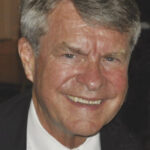“Augusta moon won’t you keep on shining on me,” sang Pat Simmons of the Doobie Brothers to the crowd celebrating the life of singer James Brown.
Brown would have been 75 years old on May 3 had he not died of pneumonia and congestive heart failure on Christmas Day 2006.
The people of Augusta, Ga. along with the Doobie Brothers, Branford Marsalis and members of Brown’s backup band, the Soul Generals, celebrated his life with a nine-hour “Payback Concert” on Augusta Commons two Saturday’s ago.
When I was notified the Doobie Brothers were headlining the show, I bought a plane ticket and moved my vacation to attend the event. I was not disappointed.
Brown loved the city he grew up in and continued to live in or near Augusta his entire life. His daughter and son appeared at the concert along with other relatives.
On a sultry spring night, the “Payback Concert” was held a block from the Savannah River as a thank you to Brown’s family and to raise funds for the Augusta Museum of History and its new James Brown exhibit.
Branford Marsalis played a set he said visited the more rhythmic side of jazz featuring some very funky playing from his drummer Jeff “Tain” Watts.
Doobie Brothers drummer Ed Toth and sax player Marc Russo came out into the audience to listen to Marsalis’ band. The crowd, which was sparse much of the day, increased when the Doobie Brothers took the stage.
Brown’s influence on the Doobie Brothers can be heard in founding member Tom Johnston’s choppy guitar riffs in songs like “Long Train Runnin’.” Johnston credited seeing Brown perform live in 1963 as a major inspiration in his playing.
As a drummer, I have always been mesmerized by Brown’s music. In a documentary film about Brown playing continuously in the museum, he said he wrote songs rhythmically making every instrument part like a drum part.
Too much for one drummer to handle, Brown worked with two drummers on stage, something the Doobie Brothers have in common with the “Godfather of Soul.” Brown was famous for fining his drummers money from their paychecks if they dropped a beat on stage.
He would turn towards them and wave five fingers adding up the fine in increments often reaching $75.
The museum display gave me the chills. It featured a number of Brown’s personal items including his suits, photos, records and even his asthma inhaler, hair straightener, a Bible and his diabetes journal.
His life was not an easy one, growing up in extreme poverty.
Brown’s mother left the household when he was four years old. He sang and danced for pocket change as a child at his aunt’s house of ill repute.
His talent for music became apparent at an early age when he swept floors in a local church to have access to the piano where he learned to play “boogie woogie.”
Brown was sentenced to prison in his teen years where he met Bobby Byrd, the leader of a gospel group that performed at the prison. Brown joined the group after his release and steered the group towards popular music.
Brown rose to the top of the “Flames” and seemed to reinvent rhythm and blues music. As a solo artist, he created classic hits such as “I Got You (I Feel Good),” and “Papa’s Got a Brand New Bag,” “Say It Loud, I’m Black and Proud,” and “Living in America.”
The name of the concert was “Payback” but it referred to gratitude. One point driven home by Brown in the documentary film, he believed “vengeance is the Lord’s job.”
Dr. Martin Luther King Jr. was assassinated the day before Brown was scheduled to play a concert in Boston Gardens. The show was initially cancelled but reinstated and televised live in Boston. Brown urged members of the community to honor King “in peace.”
There was a sense of unity in the audience in Augusta between races, age groups and music styles.
Thank you, James Brown, we owe you.






